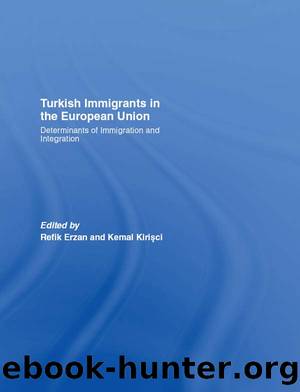Turkish Immigrants in the European Union by Refik Erzan Kemal Kirisci

Author:Refik Erzan, Kemal Kirisci [Refik Erzan, Kemal Kirisci]
Language: eng
Format: epub
ISBN: 9780415414012
Barnesnoble:
Publisher: Taylor & Francis
Published: 2007-07-31T00:00:00+00:00
Conclusion
Austria and Belgium are relatively small countries. A significant proportion of the population residing in both countries consists of immigrants from non-EU countries. Both countries have similar histories of (recent) immigration. In the 1960s and 1970s, guest workers were encouraged to come and settle temporarily. However, the economic downturn that followed the oil crisis in 1973 accompanied by major structural changes in each economy led to the decision to stop the recruitment of labor from abroad. However, guest workers not only stayed on and became immigrants, but immigration has continued through family reunification. Immigrants of both countries have difficulties integrating into the labor market and lag significantly behind the host society in respect of educational performance, which in turn aggravates their employment situation. The difficulties that immigrants face regarding integration have played a critical role in fueling anti-immigrant feelings. The rise of the Right in the domestic politics of both countries impacted on the evolution of immigration policies in each country in respect of employment and especially citizenship rights. Often these policies have caused the challenges of integration that immigrants face to become even greater.
On the labor market, Turkish migrants fare worse than the other migrant communities, both in Austria and Belgium. There are, however, some remarkable differences between the countries regarding unemployment figures. The unemployment rate is much higher in Belgium than in Austria. In Belgium, foreigners in general and Turks in particular are much more frequently unemployed than the Belgians. In comparison, the unemployment rate of foreigners in Austria is only slightly higher than the unemployment rate of the Austrians. The employment rate of the foreigners in Austria is higher than that of the Austrians. The situation in Belgium is the opposite: here, the Turkish population participates less in the labor market than the Belgium population.
Austria sanctions unemployment. An extended period of unemployment can cost immigrants the legal base of their stay. This is not the case in Belgium, where there is no limit to the duration of unemployment benefits for breadwinners and single persons. There is no link between any benefit entitlement and the right to stay in the country. Belgian unemployment insurance leads to what is called the unemployment trap, since it discourages the labor force from re-entering the labor market. This is one of the factors accounting for the high unemployment rate of the Turkish population in Belgium.
The Turkish population in Austria and Belgium emigrated from Turkey around the same period in history. Forty years later, the socio-economic position of the Turkish migrants in both countries is very similar. The Turkish men, as well as Turkish women, have a low level of education, even when compared with other migrant groups. This is a central factor that leads to a poor labor market position. They are often unemployed or occupy positions in the least favorable sectors and earning less than other laborers. The second generation generally has not done much better than their parents. Turks who naturalized and acquired the nationality of the host country occupy apparently slightly better positions, but it is hard to prove any causality.
Download
This site does not store any files on its server. We only index and link to content provided by other sites. Please contact the content providers to delete copyright contents if any and email us, we'll remove relevant links or contents immediately.
Adding Value to Policy Analysis and Advice by Claudia Scott; Karen Baehler(457)
Sociological Perspectives of Health and Illness by Constantinos N. Phellas(445)
Race and American Political Development by unknow(443)
American Government and Politics Today by Steffen W. Schmidt Mack C. Shelley Barbara A. Bardes(432)
Human and Global Security : An Exploration of Terms by Peter Stoett(426)
Control Of Oil - Hardback by Kayal(409)
Entrepreneurship Education and Training: The Issue of Effectiveness by Colette Henry Frances Hill Claire Leitch(372)
The Catholic Church and European State Formation, AD 1000-1500 by Jørgen Møller(357)
Materializing the Middle Passage by Jane Webster;(357)
The World According to China by Elizabeth C. Economy(345)
Left Is Not Woke by Susan Neiman(329)
Theories of Counseling and Psychotherapy: A Case Approach by Nancy L. Murdock(318)
Turkey's Relations with the West and the Turkic Republics: The Rise and Fall of the Turkish Model by Idris Bal(315)
Cross-Cultural Child Development for Social Workers by Lena Robinson(312)
Advances in Child Development and Behavior, Volume 37 by Patricia J. Bauer(298)
Japan's Ainu Minority in Tokyo by Mark K. Watson(297)
Laboratory Life by Bruno Latour(294)
Beyond Service: State Workers, Public Policy, and the Prospects for Democratic Administration by Greg McElligott(285)
The Oxford Handbook of Museum Archaeology by Stevenson Alice;(276)
